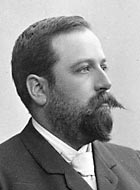Carolus Wrede
|
Baron Carl Gustaf Garibaldi Fabian Wrede af Elimä |
|
|---|---|
 |
|
| Born |
27 December 1860 Kaarina, Grand Duchy of Finland |
| Died | 15 May 1927 (aged 66) Helsinki, Finland |
| Occupation | industrialist |
| Board member of |
|
| Spouse(s) | Siri Maria née Söderhjelm |
| Children |
|
| Parent(s) | Wilhelm Otto Casper David Wrede af Elimä and Hedvig Johanna Wilhelmina Gustava née Armfelt |
| Manager of Åbo Jernmanufaktur Ab | |
|
In office 1906 – 1918 |
|
| Manager of Åbo Waggonfabrik C. Wrede & C:o | |
|
In office 1906 – 1918 |
|
| Manager of Ab Crichton | |
|
In office 1922 – 1924 |
|
| Manager of Mutual Insurance Company Sampo | |
|
In office 1922 – 1924 |
|
Baron Carl Gustaf Garibaldi Fabian "Carolus" Wrede af Elimä (27 December 1860 — 15 May 1927) was a Finnish industrialist.
Wrede studied five grades in Turku and in 1881 started his career at Hackman & Co. in Viipuri. After a short entrepreneurship period in 1884–1887 he returned to the company to lead Sorsakoski sawmill in Leppävirta. During Wrede's leadership the portfolio moved from timber to cutlery.
In 1902 Wrede bought Lehtoniemi Shipyard and Engineering works.
Wrede moved to Turku in 1906 and became manager of Åbo Jernmanufaktur and Åbo Waggonfabrik. In 1922–1924 he managed shipbuilder Ab Crichton and insurance company Sampo.
Wrede was born in Kaarina, close to Turku in a large family as one of the youngest children. His parents were major, Baron Wilhelm Otto Casper David Wrede af Elimä and countess Hedvig Johanna Wilhelmina Gustava née Armfelt. Carolus was still young when his father died. He studied five grades in Swedish-speaking classical school in Turku in 1873–1880.
In 1881 Wrede went to work for Hackman & Co. in Viipuri. Wrede started his own business in 1884 when he founded a galvanisation plant in Viipuri. After three years he sold the plant to Seth Sohlberg.
Wrede moved back to Hackman & Co. to manage Sorsakoski sawmill. He criticised the machinery and facilities, which he regarded outdated. He wanted the company to build a bobbin factory and a groundwood mill; however, the Hackman family was not willing to make such large-scale investments. The sawmill production capacity grew significantly in 1891 after costly renewal of machinery. Raw material availability was ensured by buying forests in Savonia.
...
Wikipedia
